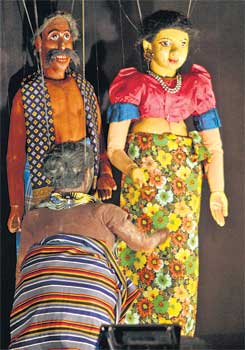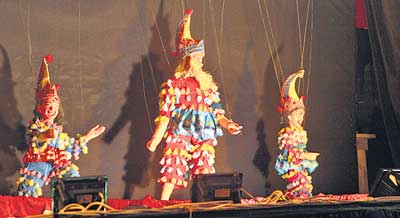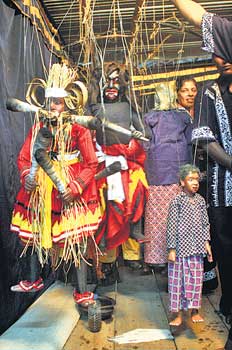
|
The art of puppetry These actors are made of wood and paint – policemen and princes, beautiful women, and ugly short men, dancers and jokers; they move at the tug of a string, dancing, hopping, and leaping at the puppeteers command. We don't normally see too many puppets around because they just aren't as popular as they used to be. Unfortunately, because of this, very few people know that in Sri Lanka, puppetry is an ancient and well developed art form.
Last week, two shows held at Vihara Mahadevi Park, may have helped to change that. The shows were organised by Alliance Francaise, Goethe-Institute, and British Council, in collaboration with the Vibhavi Academy of Fine Arts. These institutions are the ones responsible for a programme called Artlink, which brings together different foreign and Sri Lankan artists every year. This year, they chose to focus on puppetry, choosing 15 local puppeteers from places like Ambalangoda, Piliyandala, and Horana, and three foreign artists from France, Germany and the United Kingdom.
The programme gave the 18 artists a chance to share their knowledge and skills. As you can imagine, people do things very differently, in different countries. In Sri Lanka, puppeteers stick to tradition. This means that things have changed very little in many generations – they tell the same stories, make the same puppets, and sing the same songs. People enjoy this – after all, don't you like to hear your favourite story again even though you know the end? In contrast, in places like France, artists want to move as far away from tradition as they can, explains Clément Peretjako, one of the foreign artists. He himself likes to use shadow puppetry and wire puppets.
A Sri Lankan puppeteer must be more than one thing. He or she learns to make their own puppets, to sing and accompany the show on instruments, and also to manipulate the puppets themselves. It turns out that our puppets are heavier, not surprising when you consider that they are made almost entirely of solid wood and are often up to one metre in height. They are also harder to manipulate because they have fewer strings than most puppets from western countries. Ewan Hunter, an artist from the U.K., says that he learnt to move his whole body in the way he wanted the puppet to move, so that his own actions where transformed into the actions of the puppet. He even wore bells on his feet like the local artists! Alice Therese Bohm from Germany explained that puppetry is a great way of communicating. And it's true that puppetry could be used to convey many important messages. But traditional Sri Lankan puppeteers will have to change the way they do things to make puppetry relevant to the modern world. One way of opening up the world of puppetry is to make it possible for everyone to study it. This is what the Piliyandala Puppet Art Centre intends to do. Not only will they be offering regular classes for school children, they have also created a puppet museum. Though it is still small, the puppet museum has some excellent displays. So if you'd like to have something dance to your tune, here's your chance. Go, get yourself a puppet. |
|| Front
Page | News
| Editorial
| Columns
| Sports
| Plus
| Financial
Times | International
| Mirror
| TV
Times | Funday
Times|| |
| |
Copyright
2007 Wijeya
Newspapers Ltd.Colombo. Sri Lanka. |


